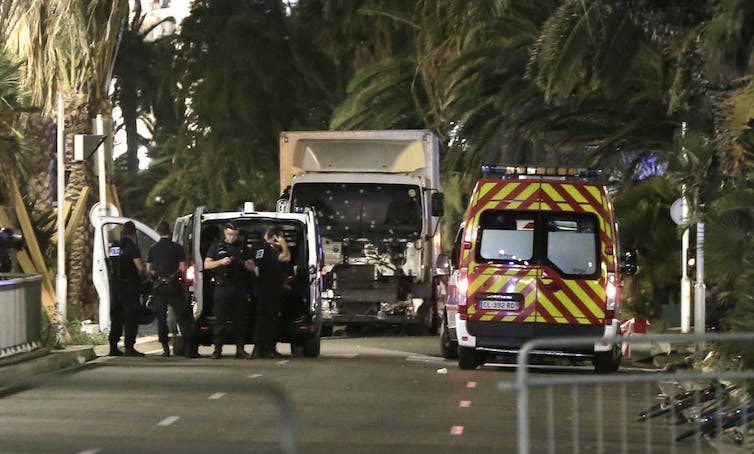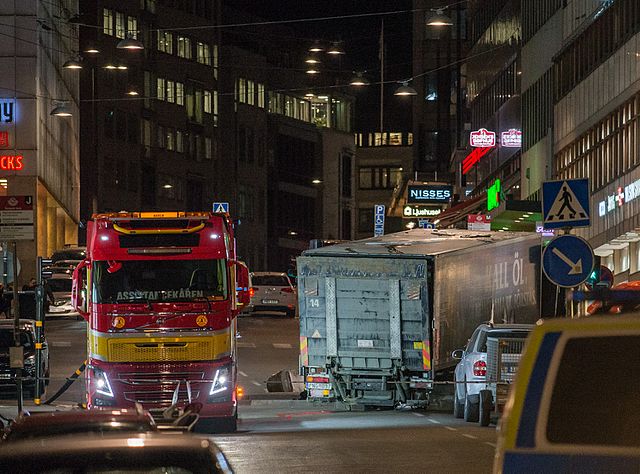By Yannick Veilleux-Lepage
The recent car-and-knife attack in London was just the latest in a string of high-profile incidents where assailants have used vehicles as deadly weapons. This type of attack has over the past few years become a feature of violent terrorism in the West and elsewhere – so where did it come from, and how did it become such a common method?
The most famous forbears of the vehicle-ramming attack were the 1981 bombing of the Iraqi embassy in Beirut and the 1983 attacks on the US marine barracks and embassy in Beirut – widely held to be the first examples of modern suicide bombing. In the 1983 attacks, explosive-laden vehicles were not only used to deliver improvised explosive devices (IEDs) but also to breach the perimeters around their targets.
In the years since, attackers have used vehicles to breach security perimeters to detonate IEDs both on land (the 2007 Glasgow Airport attack) and at sea (the 2000 USS Cole bombing). But the use of vehicle-ramming as a terroristic technique in itself, rather than as a means of delivering explosives, is a relatively recent innovation.
Its roots can be traced to Israeli-Palestinian conflict, and especially the summer of 2008, when vehicles were three times used to deliberately strike pedestrians. The first two attacks involved bulldozers, while the third used a car. By 2016, vehicle-ramming attacks in Israel had become the second deadliest form of attack carried out by Palestinians against Israelis, behind only stabbing.
It is not hard to see why. Vehicle-ramming attacks are comparatively easy to plan and carry out without detection. The weapon involved is perfectly legal to own and operate but can be devastating; that much was made plain by the 2016 truck attack in Nice, which killed 86 people and injured hundreds.
For years, vehicle-ramming attacks were largely confined to the Israeli-Palestinian conflict. But in 2010, the method got a major promotional boost when it was outlined in the second issue of Inspire Magazine, an English-language online publication purporting to emanate from al-Qaeda in the Arabian Peninsula (AQAP).
Spreading the word
With slick production values and graphics, Inspire mixed ideologically driven material with pragmatic instructional content in an effort to foster a do-it-yourself approach to terrorism. It attempted to motivate potential attackers in the West while suggesting methods of attack that did not demand much in the way of skill.
In a 2010 article entitled The Ultimate Mowing Machine, Inspire provided readers with basic instructions on how to select targets and which type of vehicle to use. It emphasised that the perpetrators would probably die in such an attack, and that they should therefore leave behind notes explaining their motivations. The article also proposed continuing the attack using firearms or melee weapons once the vehicle was immobilised.
This is the sort of attack that has cropped up in the West in the years since. In 2013, British army soldier Lee Rigby was run over by a car before being stabbed to death in southeast London. In 2014, one Canadian solider was killed and another injured after being deliberately struck by a car driven by Martin Couture-Rouleau, who had previously expressed a desire to travel to Iraq to fight with Islamic State. He was shot and killed as he charged at a police officer with a knife – an attack which the 13th volume of Inspire magazine hailed as “exemplary”.

Then came the Nice attack in summer 2016, a smaller car-and-knife attack at Ohio State University, the attack on a Berlin Christmas Market, and most recently, the incident in Westminster.
The proliferation of vehicle-ramming incidents matches the strategic vision of Anwar al-Awlaki, a popular American-born cleric affiliated with AQAP. While he was killed in a drone strike in 2011, Al-Awlaki’s sermons – widely distributed on YouTube – fundamentally shifted al-Qaeda’s strategy away from organised jihad and towards do-it-yourself terrorism.
Although its authenticity has been questioned, Inspire played a major part. It did not just disseminate know-how; it convinced its readers that the technique is “legitimate”. For a new terroristic technique to spread, potential perpetrators have to be convinced that it is just and right – and this is what Inspire achieved.
DIY terrorism
Islamic State, too, has promoted vehicle-ramming. In 2014, IS spokesman Abu Mohammad al-Adnani stated: “If you are not able to find an IED or a bullet, then single out the disbelieving American, Frenchman, or any of their allies. Smash his head with a rock, or slaughter him with a knife, or run him over with your car.”
Similarly, in late 2014, IS media group al-Hayat released a eight-minute video in which French jihadi Abu Salman al-Faranci instructs his audience: “Terrorise them and do not allow them to sleep due to fear and horror.” He then goes on to extol vehicle-ramming as an appropriate substitute for travelling to Iraq and Syria to fight: “There are weapons and cars available and targets ready to be hit … Kill them and spit in their faces and run over them with your cars.”
IS also praised vehicle-ramming attacks in the third edition of its English-language Rumiyah magazine, published in 2016, encouraging the use of trucks to carry out attacks because “very few actually comprehend the deadly and destructive capability of the motor vehicle and its capacity of reaping large numbers of casualties if used in a premeditated manner”, also instructing its sympathisers to steal such vehicles if needed.
Vehicle-ramming attacks perfectly meet the criteria for a successful terrorist technique – undemanding of skill, legitimate among their perpetrators, and highly effective. Moreover as Israel’s experience shows, they are also contagious: much like airliner hijackings in the 1960s and 1970s, the spectacle of successful attacks emboldens and inspires numerous other individuals looking for a method that fits their abilities and resources.
So whether or not the attack on Westminster really was an act of terrorism, the shockingly blunt and effective methodology it used is likely to be seen again.
Yannick Veilleux-Lepage is a PhD Candidate at Handa Centre for the Study of Terrorism and Political Violence, University of St Andrews in Scotland. The post was originally published on TheConversation.com. Republished here under Creative Commons License.
